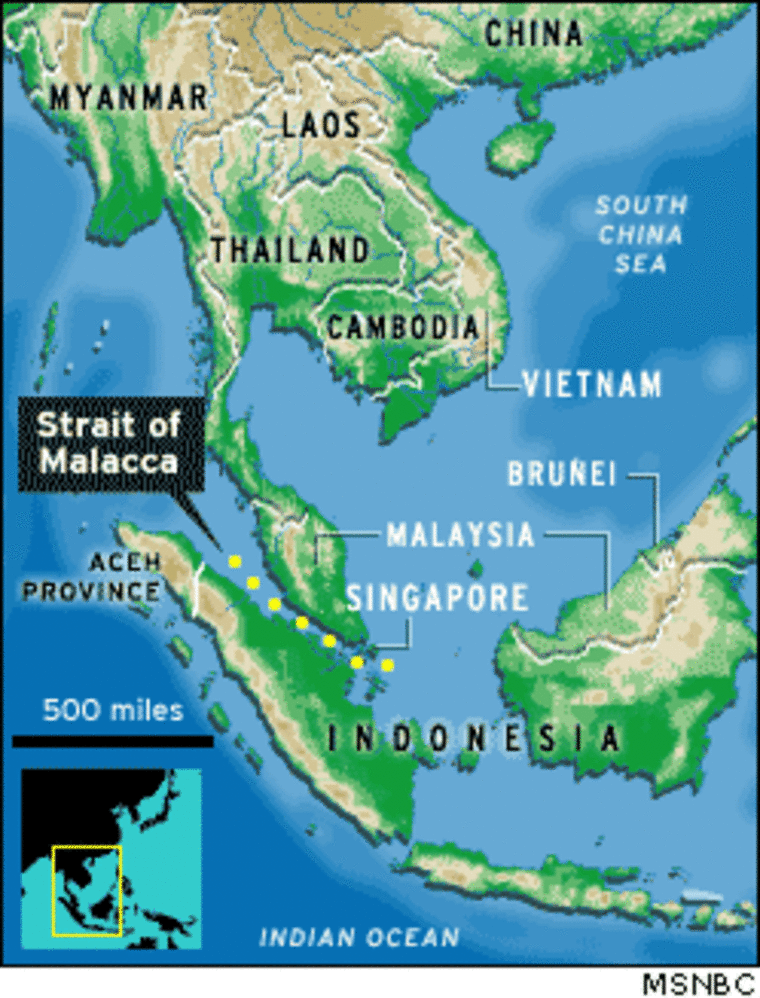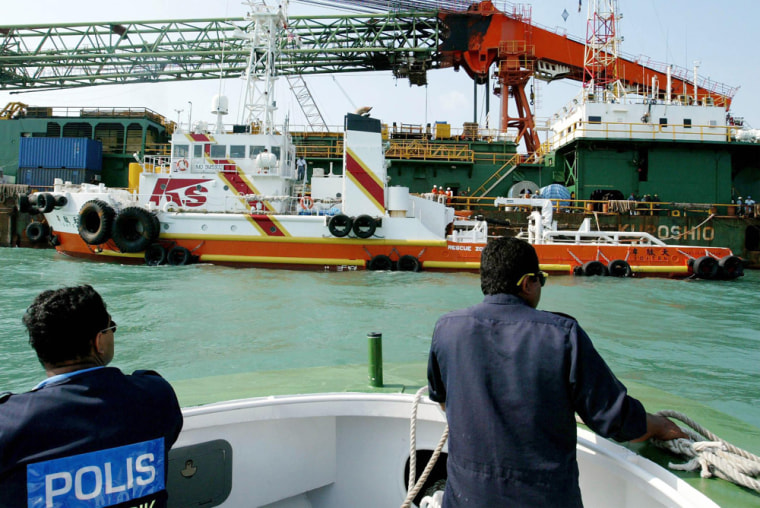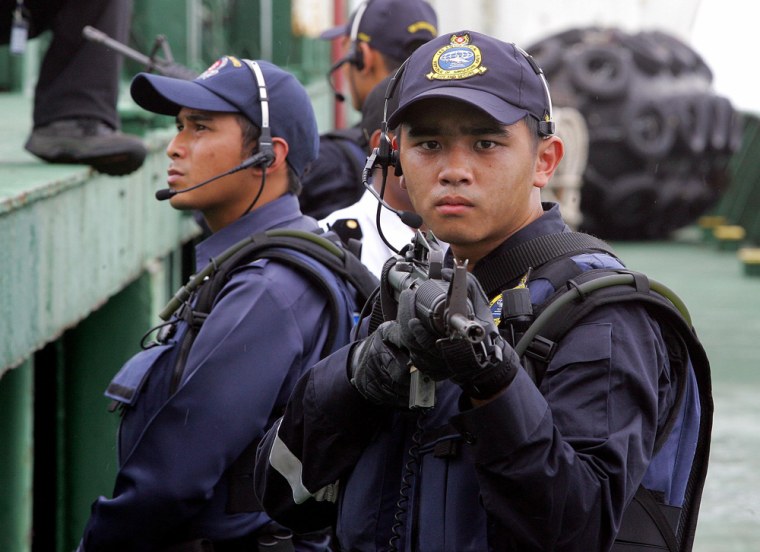When 35 pirates carrying machine guns and rocket launchers boarded a tanker laden with methane in the Malacca Strait in March, it sent a shudder through the crew, and a ripple of fear from Tokyo to Washington.
The incident marked a resurgence in attacks along one of the world’s most vulnerable and valuable shipping lanes, where things had been relatively quiet following last year's tsunami. It also served as a reminder of the risks to world trade, and of the potential for terrorism in the region.
The attack on the tanker turned out to be routine highway robbery in the strait, whose waters are shared by Singapore, Indonesia and Malaysia.
But in the nightmare scenario, terrorists using the methods of modern-day pirates seize a gas tanker and use it as floating bomb, which experts say could explode with the force of a small nuclear weapon. The damage from such an attack could go well beyond the immediate bloodshed and environmental damage, hobbling U.S. trade with Asia and cutting off essential energy supplies shipped through the narrow channel to China, South Korea and Japan.
"The threat is real and urgent," Singaporean Prime Minister Lee Hsien Loong told a regional security conference in June. "We know that terrorists have been studying maritime targets across the region."
Each year, 60,000 ships ply the Malacca Strait, carrying about half of the world's oil and one-third of its trade. That includes 80 percent of the oil used by economic powers Japan, South Korea and Taiwan.
In the 600-mile long passageway, just 20 nautical miles across at its narrowest, slow-moving cargo ships are easy to spot and chase down. Many of the attacks succeed because pirates can quickly retreat into national waters where pursuers cannot follow, and hide among the myriad islands in the region. As shipping through the strait increases rapidly, security only gets harder to provide.
While the stakes are high for the United States and its trading partners, there are limits to American security efforts since the piracy is not in U.S. waters.
Many attacks not reported
In 2004, there were 37 attacks in the Malacca Straits reported to the Piracy Reporting Center of the Malaysia-based International Maritime Bureau, making it one of the most dangerous stretches of water on earth, according to the organization.
The number dropped sharply after the tsunami hit the region on Dec. 26, presumably because of the large presence of foreign military vessels helping with aid. But in mid-March, after their departure, the maritime bureau said violent ship attacks were on the rise again.

And reported attacks, experts agree, are only a sampling of reality, since shipping companies are reluctant to report the incidents, which can cause costly delays or push up insurance rates.
"There are more and more attacks that go unreported," said Gal Luft, director of the Institute for the Analysis of Global Security."People in this industry ... admit that for them economically it doesn’t make sense."
"They don’t care about the geopolitical implications or the social cost of all this," Luft said.
As it is, the Lloyd’s and London insurance market Joint War Committee, an advisory body to insurers, reclassified the Malacca Strait as a war risk area this month — a signal to the insurance industry that regional conflict and the rising level of violence merit higher premiums for ships passing through the region.
The attacks vary. Some pirates target the contents of ship safes; others kidnap crew members for ransom, while others target high-value cargo.
One of the most recent reported incidents, technically in the Singapore Strait at the far southern end of the passage, took place on July 13, according to the International Maritime Bureau: "Six pirates armed with long knives and wearing black facemasks boarded a tanker under way via a speedboat. They took hostage two duty crewmembers and tied them up."
After destroying the ship's communication equipment, the bureau said, they took three more crew members and the captain hostage, and stole the ship's cash and other property.
More firepower
The attacks are increasingly sophisticated, employing military-style weapons and strategies.
"Because of the kinds of weapons they're carrying, they're use of flack jackets, a high degree of competency and tactical prowess ... it seems apparent that they’ve had some relatively vigorous training," says Rupert Herbert-Burns, director of intelligence and research for the Washington, D.C.-based arm of Lloyds Marine Intelligence group in London.
"We’re talking about criminals here … with more sophistication, scales of ammunition, adequate use of command and control, the use of multiple boats and the ability to seize precisely the right ship," he said.
So far, the link between these criminals and terrorism remains largely a matter of speculation and concern. Skeptics say that the United States and its allies exaggerate the threat as a way to justify asserting themselves in the region.
But there is some evidence that is cause for concern. The separatist group known by the acronym GAM, a group fighting to create an independent Islamic state in Indonesia's Aceh province, uses piracy to raise money for its long-running battle.
Of more concern is the Islamist extremist group Jemaah Islamiyah, which was behind the October 2002 nightclub bombing in Bali that killed more than 200 on the popular Indonesian resort island. Jemaah Islamiyah is known to operate throughout Southeast Asia, and has had at least some contact with al-Qaida.
Last August, Indonesia's intelligence chief, A.M. Hendropriyono, wrote in an opinion piece in the Jakarta Post that "senior Jemaah Islamiyah terrorists now in detention have admitted that attacks on Malacca shipping traffic have been contemplated in the recent past." He didn't provide any additional detail in the article, which argued for more cooperation in the region and help from the United States.
An attack in 2004, the details of which remain in dispute, also prompted intense focus on the potential for terrorism in Malacca. As it was reported, hijackers with assault rifles took over a chemical tanker, disabled the ship's radio, took the helm and apparently experimented with steering the vessel at various speeds, an incident that prompted comparisons with the Sept. 11 suicide bombers flight training.
Political obstacles to security
Since early last year, under pressure from the United States and other trading powers, Singapore, Indonesia and Malaysia have been struggling to devise a plan for better security in the narrow bottleneck.
Indeed, Adm. Thomas Fargo, head of the U.S. Pacific Command, prompted a flurry of regional security efforts when he told Congress in March 2004 that the military was looking at "putting Special Operations forces on high-speed vessels" in the strait "to conduct interdiction."
Indonesia and Malaysia, which firmly rejected the idea of a U.S. military presence in their waters, have started working, along with Singapore, on building a system of joint patrol, a move lauded by security experts.
In the meantime, however, successful attacks continue mainly because the pirates flee international waters a short distance into the Indonesian archipelago, where Malaysian and Singaporean vessels cannot pursue them.
"If those three countries agree on hot pursuit into each others territorial waters, that would be big progress in terms of cooperation," said Yoichiro Sato, associate professor at the Asia Pacific Center for Security Studies in Hawaii.

But the poor state of Indonesia's military remains a major obstacle to security. By some estimates, only about one-third of its vessels are even seaworthy, says Jeorg Eschenfelder, Southeast Asia editor for the World Security Network. "They have equipment problems, training problems and corruption" to complicate their fight against piracy.
Many of the pirates "are better equipped and trained than the coast guard or navies in the region," he said.
Wealthy Singapore, with its largely Chinese and non-Muslim population, is the most zealous enforcer in the region, because port and maritime services are the lifeblood of the tiny city-state's economy. It also sees the United States as a key ally in a largely Muslim region.
"Singapore is scared of its bigger neighbors, so it is trying to enhance ties with the United States," Sato said. "It actually welcomes a U.S. military presence in the region; for the same reason it invites the Japanese to be in the region with their coast guard or Self Defense Forces.
Outside nations keep eye on the problem
There's no shortage of nations with an interest in Malacca's security, but their involvement remains marginal.
Japan would like to help police the strait, and it's under pressure from shipowners to help after pirates abducted threw crew members of a Japanese-owned tugboat in March. In its most recent move, in June, Tokyo sent a coast guard patrol vessel to the region.
However, lingering sensitivities over Tokyo's World War II atrocities in Southeast Asia dictate that Japan cannot send military vessels or run patrols, and that its role will remain largely financial and technical. Even the coast guard vessel met with some resistance, and instead is being billed as a training vessel. Under Japan's own postwar constitution, it cannot export arms.
For now, Washington has taken a softer stand on the Malacca Straits, taking the lead of the newly appointed chief of the U.S. Pacific Command, Adm. William Fallon, who has said Malaysia, Indonesia and Singapore can do a "very adequate" job of safeguarding security.
Support from the United States is focused on providing technology, reconnaissance data and running joint exercises to bolster local patrols.
Sato said risks in the straits may also prompt the United States to lift restrictions on military sales to Indonesia that were imposed in the 1990s because of alleged human rights abuses by its military.
Meanwhile, U.S. Defense Secretary Donald Rumsfeld held security meetings in Southeast Asia in June, urging coastal nations to work together on Malacca security, a reminder that the United States is standing by to protect its interests.
